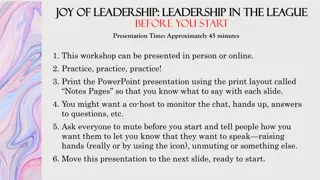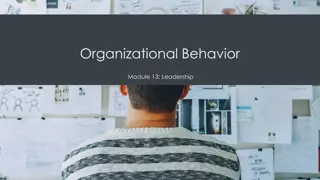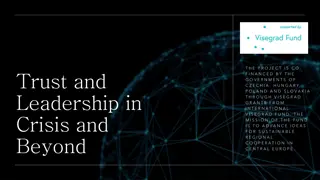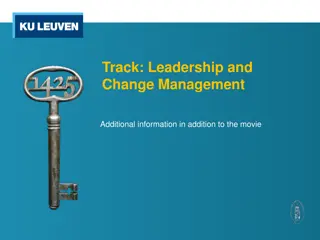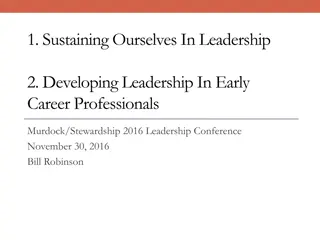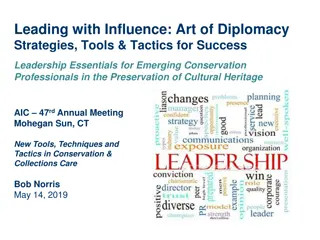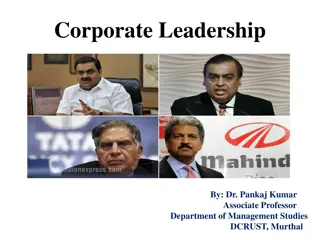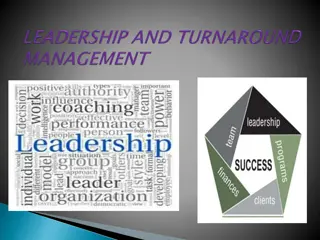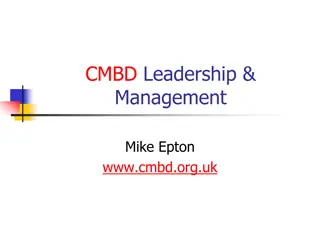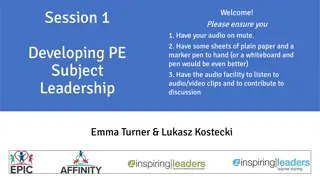Change Leadership: Challenges and Strategies
Embracing change leadership involves inspiring teams to innovate and adapt in complex environments. Effective management and leadership play distinct roles in fostering organizational growth. Understanding the differences between management and leadership is essential for navigating change successfully. This content highlights the importance of collective leadership in driving transformation within communities.
Download Presentation

Please find below an Image/Link to download the presentation.
The content on the website is provided AS IS for your information and personal use only. It may not be sold, licensed, or shared on other websites without obtaining consent from the author.If you encounter any issues during the download, it is possible that the publisher has removed the file from their server.
You are allowed to download the files provided on this website for personal or commercial use, subject to the condition that they are used lawfully. All files are the property of their respective owners.
The content on the website is provided AS IS for your information and personal use only. It may not be sold, licensed, or shared on other websites without obtaining consent from the author.
E N D
Presentation Transcript
Everyone in this room has a role in change leadership. We can share in this challenge and share our experiences. Being a change leader is difficult. Inspiring staff, coalition/REOW members, stakeholders to change their communities in ways that have never been seen and in the face of opposition can be a daunting challenge. Increasingly complex communities and problems require talents, creativity, and leadership of everyone.
Adapted from Leadership Development Academy by Ellen B. Kagen, MSW, Georgetown University, Leadership for Systems Change, sponsored by ODMHSAS Systems of Care. Today is just a brief overview.
Leaders have people follow them, while managers have people who work for them. A successful business owner needs to be both a strong leader and manager to get their team on board to follow them towards their vision of success go2HR Leaders lead people. Manager managetasks changingminds.org
Management and leadership create different experiences and feelings
Management and leadership create different experiences and feelings Management Leadership
Management and leadership create different experiences and feelings Management Stable Leadership Unstable
Management and leadership create different experiences and feelings Management Stable Safe Leadership Unstable Hard
Management and leadership create different experiences and feelings Management Stable Safe Consistent Leadership Unstable Hard Uncomfortable
Management and leadership create different experiences and feelings Management Stable Safe Consistent Calm Leadership Unstable Hard Uncomfortable Anxious
Management and leadership create different experiences and feelings Management Stable Safe Consistent Calm Order Leadership Unstable Hard Uncomfortable Anxious Chaos
Management and leadership create different experiences and feelings Management Stable Safe Consistent Calm Order Status Quo Leadership Unstable Hard Uncomfortable Anxious Chaos Resistance
If you want to learn more.Unnatural Leadership: Ten New Leadership Instincts by David L. Dotlich and Peter C. Cairo.
Steps: 1. Use teams of individuals with different types of skills and experience to encourage creativity and breakthrough thinking. Conduct or participate in brainstorming sessions. Set goals and objectives which encourage creativity and innovation. Recognize and reward suggestions for continuous improvement. Prevent fear of failure from blocking opportunities for breakthrough thinking. Learn how to overcome your own fears of doing the wrong thing and taking prudent risks. Practice asking yourself, What s the worst that can happen? 2. 3. 4. 5. 6.
Steps: 1. 2. Admit your mistakes. Encourage people to talk about how work is affecting them. Be willing to express your fears. Create conversations with back and forth dialogue. Engage in meaningful dialogue with people who aren t part of your group. Adopt and encourage a learning mentality for parts of the organization that you and your team don t know much about. Make time for reflection and self discovery for yourself and your team. 3. 4. 5. 6. 7.
Steps: 1. Adopt a learning attitude toward your vulnerabilities. Anticipate situations that give you problems and mentally rehearse for them. Talk to others who have faced what you are facing and get advice from them. Watch people you believe handle the situations well. Learn to look at negative feedback and criticism as potentially useful information that you need to understand more fully. Think about how you handle high pressure situations and identify ways you can handle them more effectively. Solicit feedback from others regarding how you handle stressful situations. Make a point to observe how other leaders deal with stressful situations. Encourage your direct reports to acknowledge their shadow side, and provide coaching and feedback that can help them learn how to manage negative consequences. 2. 3. 4. 5. 6.
Steps: 1. Use the paradox management tool for decisions that have no real long-term solution. Avoid trying to answer questions when there is no solution just because you believe people can t handle uncertainty. Pay attention to changes in the external environment that can have an impact on a significant paradox you are trying to manage. Work on clarifying what is important to you (for example, your values and beliefs), so it can be applied in situations where the data available do not provide a clear direction Be open about the existence of paradoxes, and teach how to manage them. Challenge yourself to understand the upside and downside (the competing forces) for each decision you need to make. 2. 3. 4. 5. 6.
Steps: 1. 2. Encourage people to say what s really on their minds. Don t withhold your ideas and opinions, even if you don t agree with others. Hold open monthly meetings with no agenda. Encourage people to ask questions and communicate barriers interfering with their effectiveness. Spend time with your team to analyze barriers to timely, honest, and clear communications. Create task forces and project teams comprising people with different experiences, skills and abilities. Avoid shooting the messengers with bad news. Make sure that all sides of an important issue get examined. Assign someone to be the devil s advocate Design meetings that encourage group discussion and debate. Survey the team at the end of the meeting to assess how effective it was (e.g. was everyone s voice heard?). 3. 4. 5. 6. 7. 8. 9.
Steps: 1. Spend time getting to know your direct reports as individuals. Express your confidence in their ability to deliver results. Experiment with giving others the benefit of the doubt instead of doubting their ability to deliver. Pay attention to how frequently you communicate your faith in others through your work, actions, and attitude. Challenge your assumptions about trust, and whether your expectations are impossible for people to meet. Be sure that your actions match your words. 2. 3. 4. 5. 6.
Steps: 1. Set a goal to review the performance of your direct reports regularly. Set stretch goals for your team. Identify someone you respect who excels at coaching and teaching. Ask her/him to coach you. After every conversation with your direct reports, ask yourself, Have I left them stronger and more capable than before? Learn about the abilities, aspirations, and ambitions of your staff, and incorporate this knowledge into your work with them. Develop a plan for assessing each direct report s need for coaching. Have each one prepare a list of areas in which he/she thinks coaching would be helpful. Meet individually with ach person and agree on a coaching contract. Set a goal to review each direct report s performance once a quarter and provide feedback. Don t ignore performance problems; act as soon as they arise. Talk to your direct report(s) on the level of involvement they want from you in their work. Learn how to be effective at giving and receiving feedback. Set a goal for yourself to assess and develop a full understanding of the knowledge, skills, abilities, and career prospects of each of your direct reports. Foster peer coaching by example; pick a colleague you trust, and coach each other. 2. 3. 4. 5. 6. 7. 8. 9. 10. 11. 12.
Steps: 1. 2. Reward people based on their ability to connect to others. Stay informed by being out in the marketplace and in touch with customers, competitors, analysts, and academicians. Develop principles that influence everyone in your organization to work toward the same goals. Identify colleagues whose support is important to your success, and make it a point to have regularly scheduled meetings or at least informal conversations over coffee/tea or lunch. Think about departments and organizations that could benefit from knowing what you are doing, and share information with them. Form a community of practice around a shared purpose. Check out suppliers that have web-based products and services for connecting people, such as particiapte.com, communispace.com, or placeware.com. Set a goal to learn about the priorities of other departments and functions. Develop a plan for taking a short-term assignment in another functional area. Arrange visits to other companies to benchmark best practices. Look for assignment with exposure to multiple business functions. Don t stay in your office. Make sure that you are connecting with people and building relationships. Seek out best practices both internally and externally. 3. 4. 5. 6. 7. 8. 9. 10. 11. 12.
Steps: 1. Learn how to influence others effectively in a matrix structure by building cross-organizational relationships with key people. Engage in a meaningful dialogue with your team about your style. Encourage constructive criticism and avoid defensiveness. Use a more informal and spontaneous interactions to check in on important projects. Set a goal to empower your staff, and give them the freedom to fail. Pay attention to how much your staff micromanage their teams/workgroups/coalitions. Make a point to respect boundaries of others by not insisting that people drop what they are doing and respond immediately. Recruit top players who can be given independence to meet their responsibilities. Refrain from sending too many e-mails asking for status reports. Spend time confronting your own anxiety about why you have difficulty letting go. Let go of control by creating clear performance expectations. Agree on checkpoints and milestones. Don t schedule meetings impulsively unless absolutely necessary. Pay attention to how much you trust your team, and don t be afraid to delegate the tough issues. 2. 3. 4. 5. 6. 7. 8. 9. 10. 11. 12.
Steps: 1. Be aware of the assumptions you are making every time you make a key decision or take important actions. Identify the obstacles that are standing in the way of challenging the conventional wisdom of how things are done in your organization. Set objectives, and take action to overcome these obstacles. Make time for activities that will help you gain new perspectives on your work, including putting yourself in new situations, listening to people with different points of view, and exposing yourself to the ideas of first-class thinkers. Enroll others in challenging worn-out assumptions and crusading for change. Spend time reflecting and challenging basic assumptions about doing business. Set a goal to act with courage, and challenge conventional wisdom. Make a point of bringing new, energizing ideas and fresh perspectives into your team. 2. 3. 4. 5. 6. 7.
Possible Activities: What are some of the challenges of leading staff, stakeholders, and/or coalitions to change your community? What is working when leading staff, stakeholders, and/or coalitions to change your community? What s the biggest thing you can do to lead your staff, stakeholders, and/or coalitions to have a vision for change?












